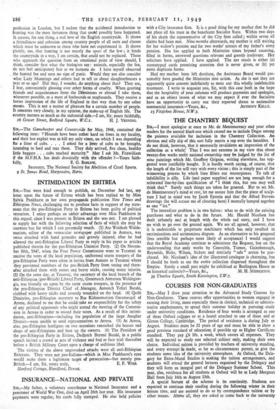THE CHANTREY BEQUEST
must apologise at once to Mr. de Montmorency and your other readers for the mental black-out which caused me to include Degas among the painters available for inclusion in the Chant:my Collection. An obvious and silly slip of this sort fully merits a rap over the knuckles. I do not think, however, that it necessarily invalidates an impression of the collection as a whole: That I was not extreme in my view that about twenty-five works merit national ownership may be judged by the list of nine paintings which Mr. Geoffrey Grigson, writing elsewhere, has sug- gested were justifiably bought. It is hardly worth saying, of course, that the length of the list will vary with every visitor ; this is simply part of the winnowing process by which lime filters out masterpieces. To talk of infallibility is silly. Life (and paper supplies) are not long enough for a reiterated line-by-line qualification of "I think this, but you may well think that." Surely such things are taken for granted. But to set Mr. de Montmorency's mind at rest, let me assure him that the piece of sculp- ture I had in mind was by Jacob Epstein and that the Alfred Stevens drawings (he will accuse me of cheating here) I mentally lumped together as one "lot."
The immediate problem is in two halves: what to do with the existing purchases and what to do in the future. Mr. Harold Nicolson has dealt urbanely and at length with the whole sad story, and I have no wish to go over the ground again. We are all agreed, however, that it is undesirable to perpetuate machinery which has only resulted in recriminations and acrimonious dispute. As an alternative to his proposal (less sensible but perhaps more likely of acceptance) I would suggest that the Royal Academy continue to administer the Bequest, but on the understanding that only works by Constable, Turner, Gainsborough, Reynolds, Blake, Wilson, Sickert and similarly "safe" artists be pur- chased. Mr. Nicolson's idea of the illustrated catalogue is charming, but I should be loath to see the entire collection dispersed throughout the Empire. Surely a small part might be exhibited at Burlington House as
an historical curiosity?—Yours, &c., M. H. MIDDLETON. 39 Thurloe Square, South Kensington, S.W.7.






































 Previous page
Previous page